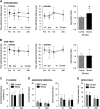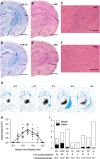Late-onset thermal hypersensitivity after focal ischemic thalamic infarcts as a model for central post-stroke pain in rats
- PMID: 25899295
- PMCID: PMC4640279
- DOI: 10.1038/jcbfm.2015.73
Late-onset thermal hypersensitivity after focal ischemic thalamic infarcts as a model for central post-stroke pain in rats
Abstract
Central post-stroke pain (CPSP) is a neuropathic pain syndrome that often develops in a delayed manner after thalamic stroke. Here, we describe a new model of CPSP by stereotaxic thalamic injection of endothelin-1. Stroke rats (n = 12), but not saline-injected controls (n = 12), developed a progressive, contralateral cutaneous thermal hyperalgesia over 4 weeks, without motor deficits. Lesions were highly focal and mainly affected the ventral posterior thalamic complex. Tchis model reproduces the infarct location and delayed hypersensitivity typical of CPSP, and may be useful to investigate its pathophysiology and test therapies targeting recovery and pain after thalamic stroke.
Figures


Similar articles
-
Targeting P(2)X(7) receptor for the treatment of central post-stroke pain in a rodent model.Neurobiol Dis. 2015 Jun;78:134-45. doi: 10.1016/j.nbd.2015.02.028. Epub 2015 Mar 30. Neurobiol Dis. 2015. PMID: 25836422
-
Late-onset hypersensitivity after a lesion in the ventral posterolateral nucleus of the thalamus: A macaque model of central post-stroke pain.Sci Rep. 2017 Sep 4;7(1):10316. doi: 10.1038/s41598-017-10679-2. Sci Rep. 2017. PMID: 28871156 Free PMC article.
-
Post-stroke pain hypersensitivity induced by experimental thalamic hemorrhage in rats is region-specific and demonstrates limited efficacy of gabapentin.Neurosci Bull. 2014 Dec;30(6):887-902. doi: 10.1007/s12264-014-1477-5. Epub 2014 Nov 5. Neurosci Bull. 2014. PMID: 25370442 Free PMC article.
-
Central post-stroke pain: clinical characteristics, pathophysiology, and management.Lancet Neurol. 2009 Sep;8(9):857-68. doi: 10.1016/S1474-4422(09)70176-0. Lancet Neurol. 2009. PMID: 19679277 Review.
-
Prevalence and Management Challenges in Central Post-Stroke Neuropathic Pain: A Systematic Review and Meta-analysis.Adv Ther. 2020 Jul;37(7):3278-3291. doi: 10.1007/s12325-020-01388-w. Epub 2020 May 23. Adv Ther. 2020. PMID: 32451951 Free PMC article.
Cited by
-
Botulinum Toxin for Central Neuropathic Pain.Toxins (Basel). 2018 Jun 1;10(6):224. doi: 10.3390/toxins10060224. Toxins (Basel). 2018. PMID: 29857568 Free PMC article. Review.
-
Disrupting interaction of PSD-95 with nNOS attenuates hemorrhage-induced thalamic pain.Neuropharmacology. 2018 Oct;141:238-248. doi: 10.1016/j.neuropharm.2018.09.003. Epub 2018 Sep 5. Neuropharmacology. 2018. PMID: 30193808 Free PMC article.
-
Tricyclic antidepressants and selective serotonin reuptake inhibitors but not anticonvulsants ameliorate pain, anxiety, and depression symptoms in an animal model of central post-stroke pain.Mol Pain. 2021 Jan-Dec;17:17448069211063351. doi: 10.1177/17448069211063351. Mol Pain. 2021. PMID: 34903115 Free PMC article.
-
Rodent Models of Post-Stroke Dementia.Int J Mol Sci. 2022 Sep 15;23(18):10750. doi: 10.3390/ijms231810750. Int J Mol Sci. 2022. PMID: 36142661 Free PMC article. Review.
-
Secondary Pathology of the Thalamus after Focal Cortical Stroke in Rats is not Associated with Thermal or Mechanical Hypersensitivity and is Not Alleviated by Intra-Thalamic Post-Stroke Delivery of Recombinant CDNF or MANF.Cell Transplant. 2019 Apr;28(4):425-438. doi: 10.1177/0963689719837915. Epub 2019 Apr 30. Cell Transplant. 2019. PMID: 31037983 Free PMC article.
References
-
- 1Klit H, Finnerup NB, Jensen TS. Central post-stroke pain: clinical characteristics, pathophysiology, and management. Lancet Neurol 2009; 8: 857–868. - PubMed
-
- 2Leijon G, Boivie J, Johansson I. Central post-stroke pain—neurological symptoms and pain characteristics. Pain 1989; 36: 13–25. - PubMed
-
- 3Flaster M, Meresh E, Rao M, Biller J. Central poststroke pain: current diagnosis and treatment. Top Stroke Rehabil 2013; 20: 116–123. - PubMed
-
- 4Kumar B, Kalita J, Kumar G, Misra UK. Central poststroke pain: a review of pathophysiology and treatment. Anesth Analg 2009; 108: 1645–1657. - PubMed
-
- 5Hansen AP, Marcussen NS, Klit H, Andersen G, Finnerup NB, Jensen TS. Pain following stroke: a prospective study. Eur J Pain 2012; 16: 1128–1136. - PubMed
Publication types
MeSH terms
Substances
Grants and funding
LinkOut - more resources
Full Text Sources
Other Literature Sources
Medical

